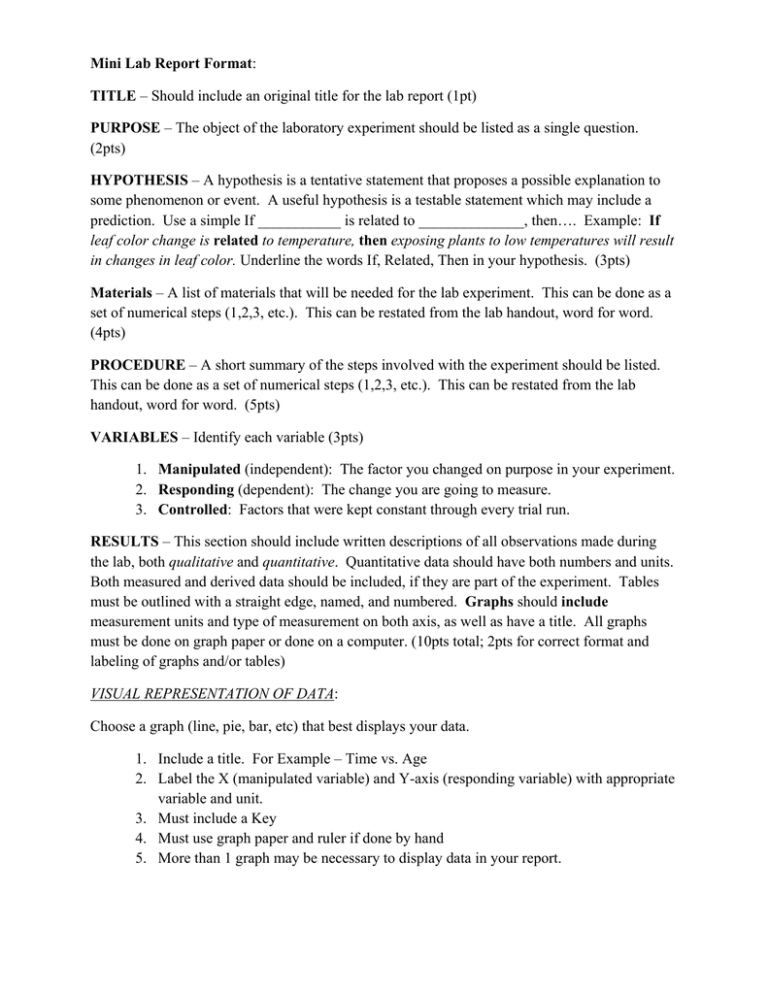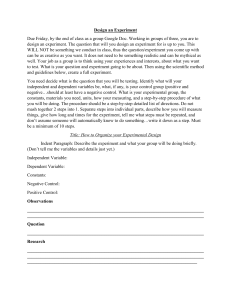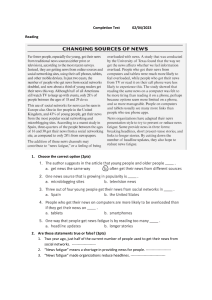Mini Lab Report Format: Guide to Scientific Writing
advertisement

Mini Lab Report Format: TITLE – Should include an original title for the lab report (1pt) PURPOSE – The object of the laboratory experiment should be listed as a single question. (2pts) HYPOTHESIS – A hypothesis is a tentative statement that proposes a possible explanation to some phenomenon or event. A useful hypothesis is a testable statement which may include a prediction. Use a simple If ___________ is related to ______________, then…. Example: If leaf color change is related to temperature, then exposing plants to low temperatures will result in changes in leaf color. Underline the words If, Related, Then in your hypothesis. (3pts) Materials – A list of materials that will be needed for the lab experiment. This can be done as a set of numerical steps (1,2,3, etc.). This can be restated from the lab handout, word for word. (4pts) PROCEDURE – A short summary of the steps involved with the experiment should be listed. This can be done as a set of numerical steps (1,2,3, etc.). This can be restated from the lab handout, word for word. (5pts) VARIABLES – Identify each variable (3pts) 1. Manipulated (independent): The factor you changed on purpose in your experiment. 2. Responding (dependent): The change you are going to measure. 3. Controlled: Factors that were kept constant through every trial run. RESULTS – This section should include written descriptions of all observations made during the lab, both qualitative and quantitative. Quantitative data should have both numbers and units. Both measured and derived data should be included, if they are part of the experiment. Tables must be outlined with a straight edge, named, and numbered. Graphs should include measurement units and type of measurement on both axis, as well as have a title. All graphs must be done on graph paper or done on a computer. (10pts total; 2pts for correct format and labeling of graphs and/or tables) VISUAL REPRESENTATION OF DATA: Choose a graph (line, pie, bar, etc) that best displays your data. 1. Include a title. For Example – Time vs. Age 2. Label the X (manipulated variable) and Y-axis (responding variable) with appropriate variable and unit. 3. Must include a Key 4. Must use graph paper and ruler if done by hand 5. More than 1 graph may be necessary to display data in your report. CALCULATIONS – This section should show all of the mathematics involved in changing all measured data into derived data. Include all units of measurement. In summary, show the mathematical operation, give the answer, and organize the two together. UNDERSTAND THAT SOME LABS DO NOT HAVE CALCULATIONS. If there are no calculations, write NOT APPLICABLE. For example: Density = Mass / Volume 20grams / 20mL = 1.0 grams/mL DISCUSSION – Some lab handouts and book experiments will include a set of questions at the end. This is ALWAYS included as part of the lab report unless otherwise stated by the instructor. (10pts) CONCLUSION – This section should answer the question, which was posed during the purpose section of your report. You must also give evidence for arriving at the conclusion, which you state. Your data should be a major source of information for your conclusion. However, it is also acceptable to use other sources (such as your text book, internet, etc) if need be. If you feel that your data is incorrect, then list possible reasons for your faulty results (do not blame your lab partner even though it is probably his/her fault ). Sometimes there are very legitimate reasons for an experiment to not go as you might have expected. In summary, pull it all together here in a paragraph. Consider the following when writing your conclusion: Restate your purpose (2pts) Restate your hypothesis (3pts), and state if your hypothesis was correct (2pts) Briefly explain your data, refer to any graphs or tables to verbally describe the results you got. If your data was incorrect due to experimental error, briefly explain what should have happened. (5pts) (3 additional pts for connecting the explanation to your table and/or graph) Use your science knowledge to explain why you did or did not get the expected results. You can use the discussion questions as a guide to help you with this section of the conclusion. (5pts) List any possible experimental errors and how you could change the lab to prevent them in the future. (5pts)



